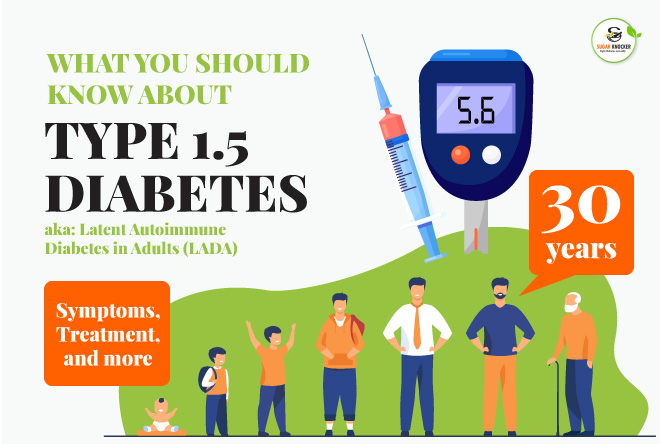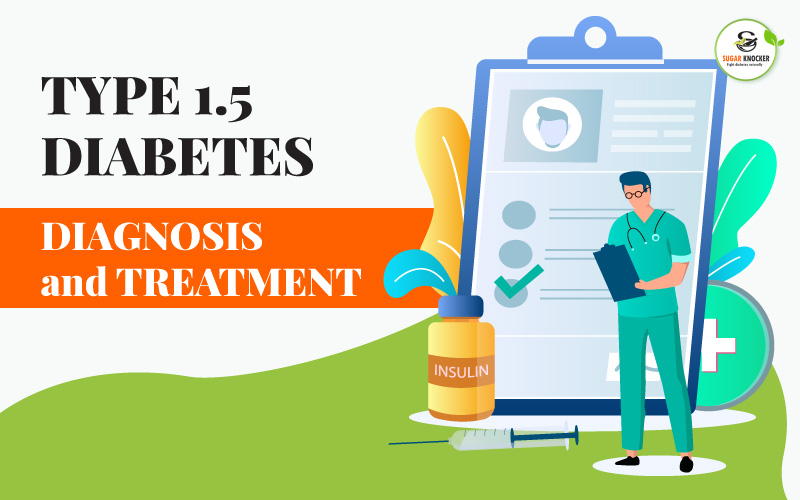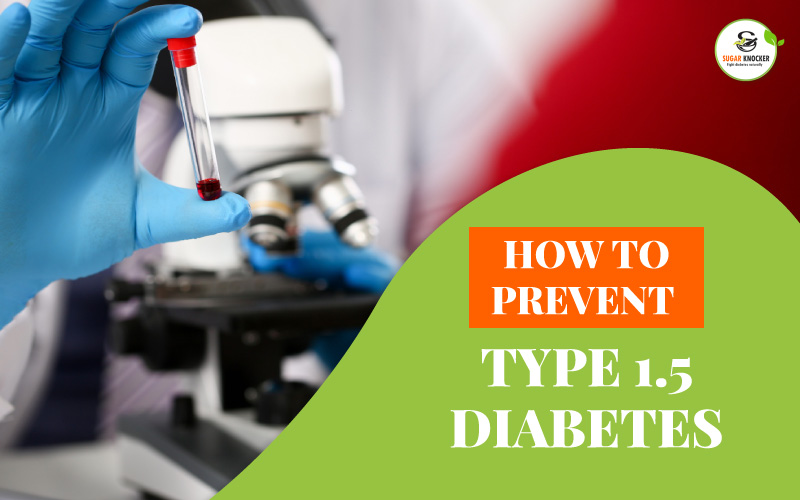
Latent autoimmune diabetes of adults (LADA), also known as type 1.5 diabetes, is a less prevalent form of diabetes that affects adults. LADA patients may exhibit signs and symptoms of both type 1 and type 2 diabetes, making LADA diagnosis more difficult.
We’ll go over what LADA is and how it varies from other types of diabetes in this blog.
What is Type 1.5 Diabetes?

Type 1.5 diabetes is a popular term that refers to type 1 diabetes condition known as Latent Autoimmune Diabetes in Adults (LADA).The term type 1.5 diabetes pertains to a kind of type 1 diabetes with some traits that are more typically associated with type 2 diabetes.
Type 1.5 diabetes, like the majority of instances of type 2, is diagnosed in adulthood. It is similar to type 2 diabetes which progresses gradually. Type 1.5 diabetes, like type 1 diabetes, is an autoimmune illness that will require insulin therapy in the future.
If you have type 1.5 diabetes, your beta cells stop functioning considerably faster than if you have type 2. LADA is estimated to affect ten percent of diabetic patients. Type 1.5 diabetes is readily mistaken as type 2 diabetes, and it happens all the time. There’s a possibility you have LADA if you’re in a healthy weight range, have a healthy lifestyle, and have been diagnosed with type 2 diabetes.
Causes of Type 1.5 Diabetes

Before diving into the causes of type 1.5 diabetes, let us first understand the distinction between type 1 and 2 diabetes:
Type 1 Diabetes
Since your body destroys pancreatic beta cells, type 1 diabetes is classified as an autoimmune disorder. These cells aid in the production of insulin, the hormone that permits your body to store glucose (sugar). Individuals with type 1 diabetes must inject insulin into their bodies in order to live.
Herbal Ingredients – Ayurvedic Herbs For Diabetes
Type 2 Diabetes
The main symptom of type 2 diabetes is your body’s resistance to insulin’s effects. Insulin resistance is caused by a combination of genetic and environmental factors, including a high-carbohydrate diet, lack of physical exercise, and obesity. Type 2 diabetes can be controlled with lifestyle changes and oral medications, but many people will require insulin to maintain blood sugar control.
Causes of Type 1.5 Diabetes:
Damage to your pancreas caused by antibodies targeting insulin-producing cells can cause type 1.5 diabetes. A family history of autoimmune diseases, for example, may have a role in the development of the disease. In type 1.5 diabetes, when the pancreas is injured, the body kills pancreatic beta cells, just as it does in type 1. Insulin resistance may be present in a person with type 1.5 diabetes who is also overweight or obese.
Read Similar Topics: Ayurvedic Medicine for Diabetes Type 1 and Type 2 in India – Knock Diabetes
Symptoms of Type 1.5 Diabetes

LADA can induce a variety of symptoms, including ketoacidosis, which causes a noticeable fruity odor on the breath and elevated blood sugar levels.
Symptoms of both type 1 and type 2 diabetes can be seen in people with LADA.
These may include the following:
- extreme thirst
- excessive urination
- increased hunger
- fatigue
- blurred vision
- cuts and bruises that heal deliberately
- Unexplained weight loss despite eating more (type 1)
- tingling, pain, or discomfort in the hands or feet (type 2 diabetes)
Diagnosis of Type 1.5 Diabetes

Since type 1.5 diabetes develops in adulthood, it is sometimes misdiagnosed as type 2. The majority of individuals with this kind of diabetes are over the age of 40, although it can strike anyone even in their 70s or 80s.
It might take a long time to get a LADA diagnosis. As type 2 diabetes develops later in life, many patients (and physicians) think they have it.
Treatments for type 2 diabetes, such as metformin, can help manage symptoms of type 1.5 diabetes until your pancreas quits producing insulin. That’s when a lot of folks realize they’ve been dealing with LADA right from the beginning. In most cases, the advancement to the requirement for insulin is quicker than in type 2 diabetes, and the response to blood sugar-lowering treatment (oral hypoglycemic medications) is poor.
Type 1.5 diabetics are more likely to fulfill the following criteria:
- They aren’t overweight.
- They’re over 30 years old when they’re diagnosed.
- Oral drugs, as well as lifestyle and nutritional adjustments, have failed to control their diabetic symptoms.
Read More: Best Ayurvedic Medicine For Diabetes
The following tests can be used to detect diabetes of any type:
- A fasting plasma glucose test, which is performed on a blood sample taken after you’ve fasted for eight hours.
- An oral glucose tolerance test performed on a blood sample taken after an eight-hour fast and two hours after consuming a high-glucose beverage
- A blood test that measures your blood sugar without taking into consideration when you last ate performed on a random basis.
- When the kind of diabetes you have is caused by an autoimmune reaction in your body, your blood can also be checked for particular antibodies.
Risk Factors of Type 1.5 Diabetes

The following are some of the risk factors for acquiring LADA:
- Obesity or being overweight
- Minimal physical activity due to low birth weight
Researchers believe that those who have several risk factors are more likely to acquire LADA. The combination of low birth weight and adult obesity, for example, may increase a person’s risk of acquiring LADA.
Psychosocial stress may also play a role in the development of LADA.
Treatment of Type 1.5 Diabetes

Type 1.5 diabetes is caused by a lack of insulin production in the body. However, because type 2 diabetes develops gradually, oral diabetic medication can help, at least in the beginning.
Individuals with type 1.5 diabetes may give positive results for at least one of the antibodies that are common in people with type 1 diabetes. You’ll require insulin as part of the treatment process when your body’s insulin production drops. LADA patients frequently require insulin within five years of diagnosis.
Insulin therapy is the most effective treatment for type 1.5 diabetes. Insulin and insulin regimens come in a variety of forms. Considering the amount of insulin, you require may change from day to day, it’s critical to keep track of your glucose levels with periodic blood tests.
Foods to take for Type 1.5 Diabetes

Initially, diet, exercise, and medication could be used to treat LADA, but insulin treatment is eventually required. Although LADA appears to react to lifestyle and medicine in the same way as type-2 diabetes does, it will not stop or reduce the destruction of beta cells, and patients will ultimately become insulin-dependent. But since diet plays a major role in the treatment, you should adhere to a proper diet for LADA.
Slowing the course of the illness, managing body weight, and maintaining ideal blood sugar levels are all dietary recommendations for LADA therapy. It has been discovered that a high-fiber, low-glycemic-index diet rich in anti-inflammatory foods and minerals is beneficial.
Finding out the healthiest meals to consume when you have diabetes is not really difficult; listed below are some diabetic-friendly foods:
Fatty Fish:
It is thought to be beneficial for the heart and lessen the risk of heart attacks and other acute coronary syndromes. It may also aid in blood sugar control.
Leafy Greens:
These veggies are high in nutrients and low in calories, and they can also aid with inflammation reduction.
Avocados:
Avocados have high fiber content, few carbohydrates, and less than 1 gram of sugar that does not affect blood glucose levels, so you can eat them without worrying about your blood sugar levels rising.
Eggs:
Consuming eggs on a regular basis may help to lower your risk of heart disease in a variety of ways. Eggs can help to reduce inflammation, enhance insulin sensitivity, boost HDL (good) cholesterol levels, and change the size and structure of LDL (bad) cholesterol.
Chia Seeds:
Chia seeds are strong in fiber but low in carbohydrates that can be digested. TheseChia seeds include viscous fiber that helps reduce blood sugar levels by decreasing the pace at which food passes through your intestines and is absorbed.
Beans:
Beans are inexpensive, nutrient-dense, and extremely beneficial. These Beans are a kind of legume that is high in B vitamins, fiber, and important minerals (calcium, potassium, and magnesium). They also have a low glycemic index, which is crucial for diabetic management.
Nuts:
Nuts are both tasty and healthful. TheseNuts are high in fiber and low in net carbohydrates in general; however, some have more than others. Consumption on a regular basis may help to decrease inflammation, blood sugar, and LDL (bad) cholesterol levels.
Prevention of Type 1.5 Diabetes

At present, there is no way to prevent type 1.5 diabetes. The development of this condition, like type 1 diabetes, is influenced by hereditary factors. The best method to avoid consequences from type 1.5 diabetes is to get a proper diagnosis and manage your symptoms early on.
People with LADA have a comparable life expectancy as people with other kinds of diabetes. Higher blood sugar levels over time can cause diabetic consequences such as renal disease, cardiovascular difficulties, eye problems, and neuropathy, all of which can have a negative impact on prognosis. Many of these issues can be avoided with appropriate blood sugar management.
For Type 1 Diabetes
People with type 1 diabetes used to have a shorter life expectancy. Improved diabetic therapies, on the other hand, are changing that pattern. A normal life expectancy is feasible with appropriate blood sugar management. Some doctors believe that starting insulin treatment as soon as you’re diagnosed can assist protect your beta cell functioning. If this is the case, getting a proper diagnosis as soon as possible is critical.
Read More: Best Ayurvedic Dietary Supplement & Most Trusted Natural Supplement
Thyroid illness Person:
Thyroid illness is more common in persons with LADA than in those with type 2 diabetes when it comes to problems that might affect their outlook. People with poorly controlled diabetes heal wounds more slowly and are more prone to develop infections.
People with LADA may have normal symptoms of type 2 diabetes, but their bodies create antibodies that impair how the body regulates blood sugar levels. Insulin injections or other drugs may be used by people with LADA to regulate their blood sugar and delay the pancreas’ deterioration. New medical discoveries show that diagnosing diabetes is more complicated than merely identifying types 1 and 2.
A deeper knowledge of the various types might assist healthcare practitioners in better identify which patients are most likely to suffer difficulties, allowing for a more individualized treatment strategy.
In terms of patients, maintaining correct blood sugar levels by regular monitoring, eating healthier food, and adopting good lifestyle choices can help to mitigate the impact of hereditary variables on the chance of developing LADA. It may also guard you against issues, allowing you to live a healthy and active lifestyle.
Conclusion
If you’ve recently been diagnosed with type 2 diabetes, keep in mind that your disease will not progress to type 1 diabetes. It’s possible, though, that your type 2 diabetes is truly LADA or type 1.5 diabetes. This is especially true if you’re in good shape and have a family history of autoimmune disorders like type 1 diabetes or rheumatoid arthritis (RA).It’s critical to get the right diagnosis for LADA since you’ll need to start taking insulin injections right away to keep your condition under control. Misdiagnosis may be aggravating and perplexing. Consult your doctor if you have any questions about your type 2 diabetes diagnosis. Testing for antibodies that indicate an autoimmune attack on your islet cells is the only approach to correctly diagnose LADA. A GAD antibody blood test may be ordered by your doctor to identify if you have the disorder.
Read More:
Ayurvedic Herbs for Diabetes – Ayurvedic Capsules for Diabetes
Ayurvedic Treatment for Diabetes: Effective Natural Solutions

